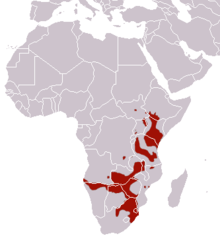Plains zebra
| Plains zebra | |
|---|---|
 |
|
| Burchell's zebra (Equus quagga burchellii) | |
| Scientific classification | |
| Kingdom: | Animalia |
| Phylum: | Chordata |
| Class: | Mammalia |
| Order: | Perissodactyla |
| Family: | Equidae |
| Genus: | Equus |
| Subgenus: | Hippotigris |
| Species: | E. quagga |
| Binomial name | |
|
Equus quagga Boddaert, 1785 |
|
| Subspecies | |
|
E. q. quagga † |
|
 |
|
| Plains zebra range | |
| Synonyms | |
|
|
E. q. quagga †
E. q. burchellii
E. q. boehmi
E. q. borensis
E. q. chapmani
E. q. crawshayi
E. q. selousi
The plains zebra (Equus quagga, formerly Equus burchellii), also known as the common zebra or Burchell's zebra, or locally as the "quagga" (not to be confused with the extinct subspecies), is the most common and geographically widespread species of zebra. It ranges from the south of Ethiopia through East Africa to as far south as Botswana and eastern South Africa. The plains zebra remains common in game reserves, but is threatened by human activities such as hunting for its meat and hide, as well as competition with and encroachment by farming on much of its habitat.
Subspecies include the extinct quagga and six recognised extant subspecies, though there is great variation in coat patterns between individuals. The striping pattern is unique among ungulates in the region, and its functions are disputed. Suggested functions include crypsis, forms of motion camouflage, social signaling and recognition, and discouraging biting flies. As of 2016, the plains zebra is classified as Near Threatened by IUCN.
The plains zebra's range is fragmented, but spans much of southern and eastern Africa south of the Sahara. Its habitat is generally but not exclusively treeless grasslands and savanna woodlands, both tropical and temperate. They generally avoid desert, dense rainforest and permanent wetlands, and rarely stray more than 30 kilometres from a water source. Predators of the zebra include lions, spotted hyenas, leopards, cheetahs and wild dogs.
...
Wikipedia

